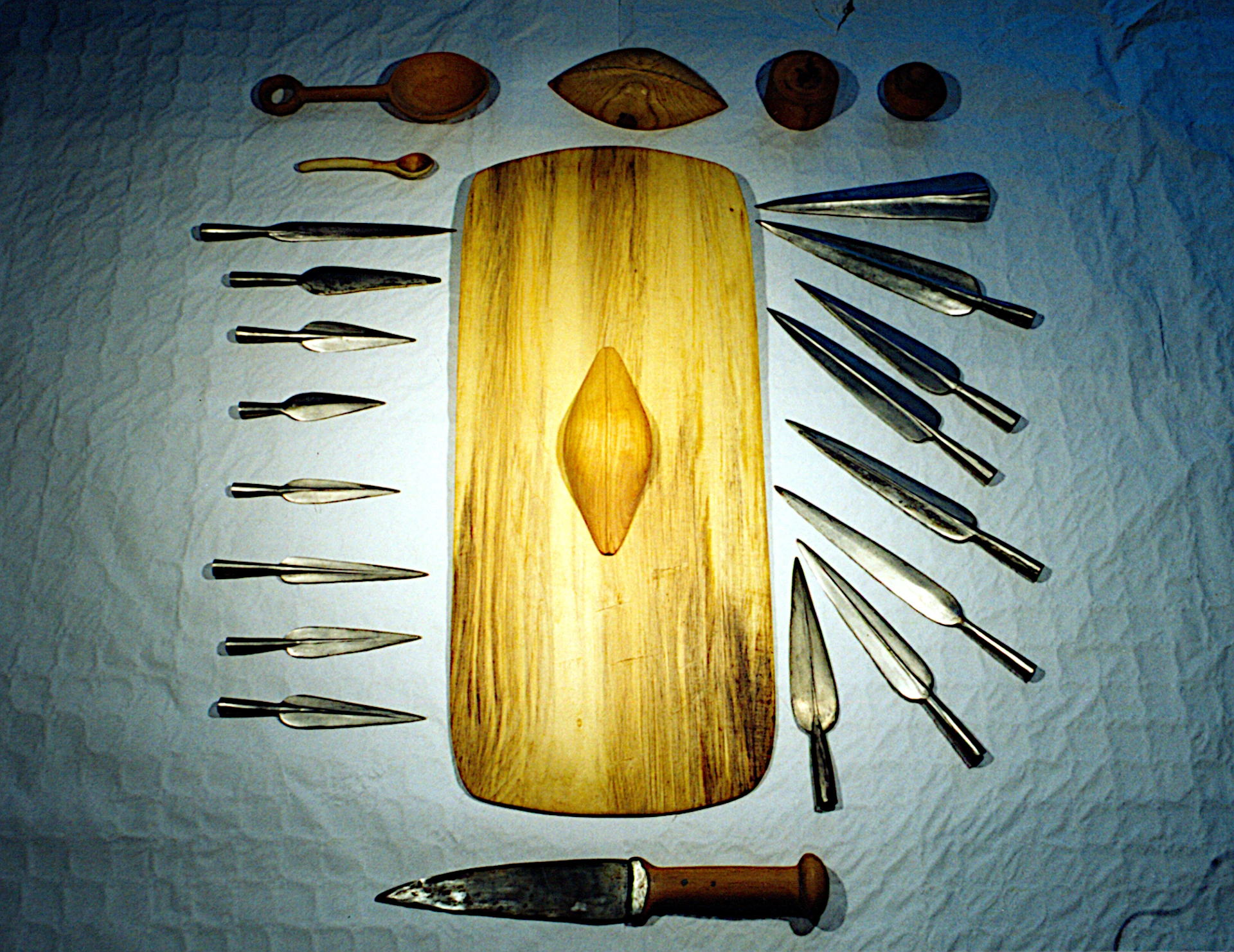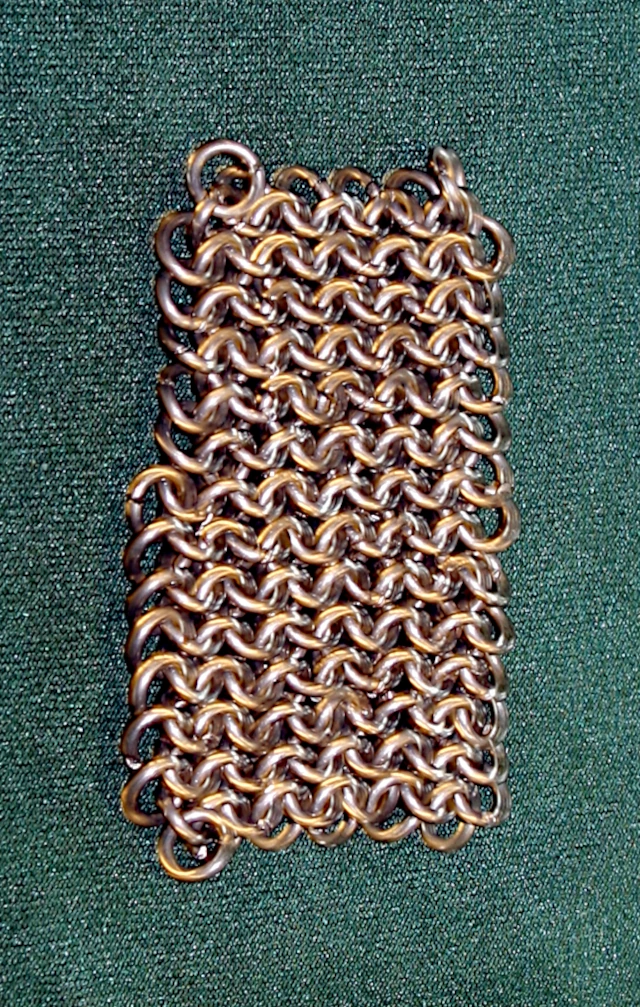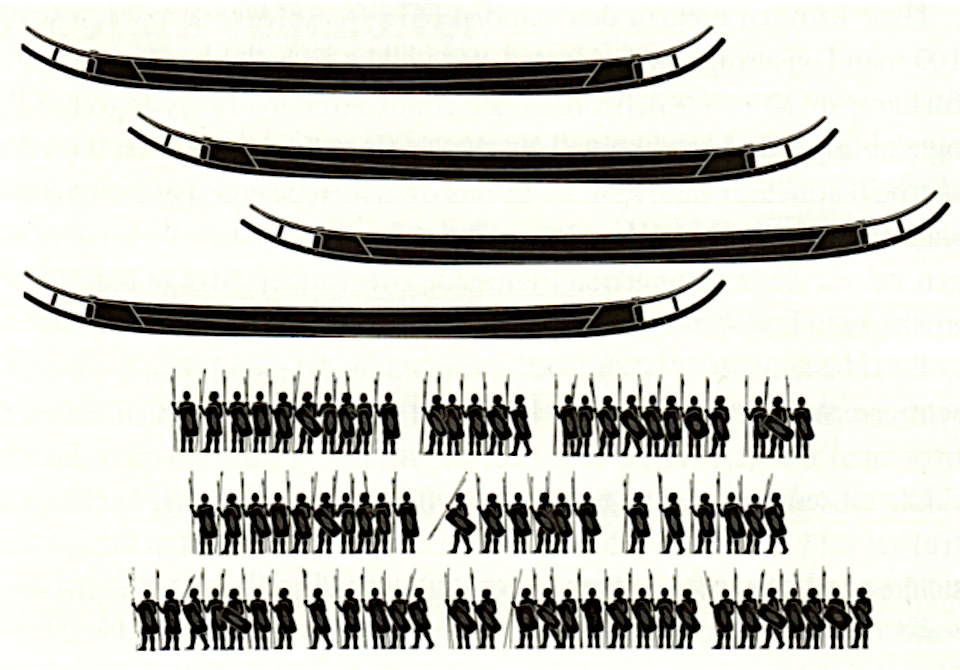Spears and swords
The Hjortspring find is a war booty offering, meaning that a victorious army sacrificed the spoils of war to the gods as thanks for the victory. This can be seen in the deliberate destruction of some of the weapons: one sword is bent in an ‘S’ shape and another at a right angle, some lance shafts have been broken. Similar destruction has occurred at the sacrificial bogs in Nydam and Illerup Ådal.
In addition to the boat, this consisted of more than 169 spearheads of various kinds. During peat digging in the 1880s, it is said that several pieces of sharp iron were thrown into a nearby fence so that people would not cut themselves when kneading the peat with their feet. There may have been over 180 spearheads (1).
There are also 11 swords of varying appearance, but they are all single-sided with a back reinforcement, like a wider rib.
Spears and swords can be seen here.
A quote from the Hjortspring find
A light, ochre-coloured layer of iron rust had been deposited in the core peat over most of an area of approximately 10 - 12 m2, stretching from the end of the bay to the west to approximately 2 m from the edge of the excavation. The peat excavation has probably removed the layer from a similar area, so that the now dissolved iron has been distributed over a 20 - m2 large area.
Closer observation of the peat mass, which has been coated with watery, powdery rust, reveals numerous extremely thin and fragile shells of small iron rings, which were undoubtedly originally joined together to form chain mail. The acidic bog water has completely dissolved and washed the iron out of the thin wire rings, leaving only the coherent rust shell that first formed on the surface of the iron. The thickness of the rust layer varied greatly, from a lighter coloured, barely centimetre-thick layer to an approximately 3 cm thick layer of almost pure ochre with fewer plant parts, where the heavy armour has slipped down into depressions on the uneven moss ground.
It was not possible to determine in what condition the whetstones had been deposited in the bog, just as it was not possible to determine their number. But it must be assumed that they, like other weapons, were torn before they were deposited. Assuming that the layer extended across the peat trenches within the area where the rust could be traced, and by estimating the area covered by chain mail at 1 m2, one would arrive at a number of 20 - 24 pieces of chain mail.
Some samples of rings have been prepared from a 2 m2 peat flake, which was taken up within the team. Most of these have a diameter of 0.6 - 0.8 [cm], some are 0.9 - 1.0 [cm] large, others only 0.4 [cm]. The very small rings may only have included 1 or 2 thread rings, the largest probably 3 - 4. An arched section of rust may perhaps be the head of a nail or hook for fastening rings together..
Despite the above, very confident description of what was found, other, later, researchers have suggested that it is not chain mail, but only ochre deposits.
We have not made reconstructions of chain mail.
Shields
The find contained a large number of shields, in fact the largest total find of shields in European prehistory!
Few of the shields are fully preserved, but there was enough material to collect 50 shields, enough for them to be measured. In addition, there were enough fragments to suggest up to 60-80 shields in the find, maybe even up to 100, but no more.
All the shields were of the same basic shape. Elongated square to oval with rounded corners (3). The shields are Celtic in shape. The Celts lived east and north of the Alps. This period was formerly known as the Celtic Iron Age, but now the term Pre-Roman Iron Age (500 BCE to year 1) is mostly used.
The reconstructed shields can be seen here.
The army
The number of spears, swords and shields is enough to arm a force of 80 men, or 4 Hjortspring-type boats. Each boat has seating for 20 people, of which 18 are paddlers, 1 is the helmsman and 1 is the skipper - he can be ‘armed’ with a paddle. In our experience, a lookout may be necessary when sailing in shallow water, but whether it's one of the paddlers at the front (10) who has the job or an extra one at the front, we don't know, but it's not a very comfortable place in the boat, there's barely room for a foot in the bottom of the boat and certainly not if, like us, they have a stretch rope mounted in the boat (4).
According to the above theory, the ordinary paddlers/warriors each had a lance and a few spears and a shield. The ‘officers’ also had a sword - it may have been the skipper and helmsman (5).
This is the most common notion of what happened in those times.
Some of the reconstructed spear and lance tips, as well as some swords can be seen here.
Another theory often put forward by some members of the Hjortspringbådens Guild is that it was a merchant ship - arms dealers - that got into trouble. Some researchers disagree, but it's a good story! The fact is that nobody knows, there is nothing written down, apart from Tacitus, who in the 1st book of 30: Historiae et Annales, describes the cruel treatment of prisoners of war and their weapons by the Germans (7).
Arguments in favour of
There are no battle marks on the shields found, except for one where a lance shaft had been driven through the shield plate, but this probably happened during the sacrifice in the bog.
Only tools, cookware and personal equipment corresponding to one boat were found.
Arguments against
I haven't heard one professional archaeologist advocate the idea of a merchant ship, but it may well be true.
About weapons in combat
Stones for use in slings
Many stones have been found in the bog, many of them between the separated boat planks; the boat was lowered lying on one side - otherwise it couldn't be in the bog - and the stones would hold it down. Jørgen Jensen (8) mentions the possibility. In Germania Tacitus (9) writes that [...] The footmen also have throwing weapons - each man several - which they hurl enormously far, naked or wearing only a light cloak. [...] he doesn't say what the throwing weapons are, they are probably spears, but they may also have had stones.
Bow and arrows
No traces of bows and arrows have been found at all (10). Apparently, these were not used for combat in this part of the Iron Age, but probably for hunting. Was it an ‘ethical’ question? Should you be able to see the ‘whites’ of your opponent's eyes so that it was only ‘honourable’ to fight man to man?
The shields
If the shield has been held vertically, you will miss a strap on the lower part of the shields that can go around the forearm close to the elbow. This is to prevent being hit in the head by the upper half of the shield if it is hit hard. It is impossible to prevent this by only holding on to the shield grip.
There is no evidence that such an elbow strap existed on the shields and we have not fitted such a strap, except for our reconstruction of shield no. 123, where there was a hole in the shield plate that could have been used for such a strap. There is a strap mounted on the shield in our exhibition.
If every warrior is supposed to have a shield, a lance and a pair of spears, how does he hold these spears?
Maybe like this: If he is right-handed, he has his shield in his left hand with an underhand grip and his alleged/defence weapon in his right. The warrior must have stood still to throw a spear, with lance and extra spear ‘parked’ in the ground. When he had no more throwing weapons, the lance would have been used in close combat.
If the shield was held horizontally, i.e. the shield handle was vertical, you don't have the problems mentioned above. You can hold the extra spears in your left hand, but they will also be vertical.
This article was put together by Ib Stolberg-Rohr, feel free to write if you have any comments.
1. F. Kaul, p. 22
2. G. Rosenberg, p. 47 - 48
2a. J. Jensen, Volume 3, p. 76
3. F. Kaul, p. 23 ff.
4. J. Jensen, Volume 3, p. 69 ff
5. J. Jensen, p. 69
6. J. Jensen, Volume 3, p. 69
8. J. Jensen, Volume 3, p. 68
9. P. Tacitus, Section 6.1, p. 92
10. J. Jensen, Volume 3, p. 68
11. O. Crumlin, Section 4.3.4 Chain mail coats, p. 153
(7)
Publius Cornelius Tacitus
(ca. 56 - 120 AD)
In his huge 30-volume work Historiae et Annales, he writes in:
BOOK I. - III. Tiberius Nero Caesar in the year 15
(…)
Here they were not far from the Tevtoburg Forest, where the bones of Varus and his legions were supposed to lie unburied.
61
‘In the centre of the plain lay whitened bones, scattered or collected, according as they had fled or resisted; beside them were pieces of spears and limbs of horses, and then human heads nailed to tree trunks. In the neighbouring groves stood barbarous altars, where they had slaughtered tribunes and centurions of the first rank.’
(...)
The result can be seen at Mosgårds Museeum in the exhibition about Alken Enge (Skanderborg), the sacrifices are from around year 1.






